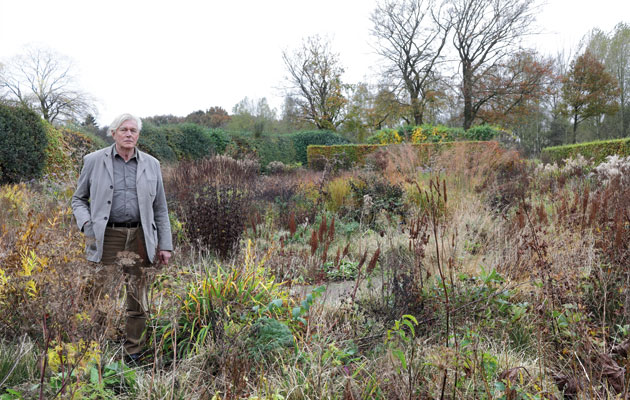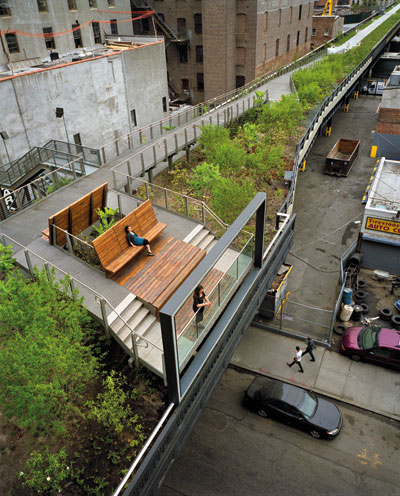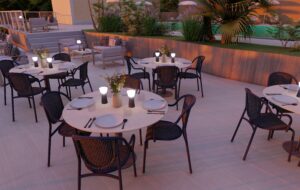|
|
||
|
From the High Line to the Serpentine, the Dutch landscape designer has redrawn the boundaries between architecture and nature, bringing the wild into the heart of the city. Riya Patel went to meet him in his studio in a remote part of the Netherlands “A real gardener would cut that back,” says Piet Oudolf, pointing to a dry branch that pokes out over the path of his garden in Hummelo, a remote part of the Netherlands. We’re touring his grounds in their autumnal phase: a sea of tall brown grasses and hazy perennials dotted with anemone seed heads and the odd purple aster still in flower. The brilliant mess of it all – why the 70 year old doesn’t think of it as a “real” garden – is beguiling. But it takes a while before an untrained eye can see what Oudolf sees. Over 35 years, the landscape designer has honed an independent and influential practice that goes against an established view of using plants merely as decoration. He’s lent his signature approach – a belief that planting should be fundamental to architecture and more truthful to nature’s cycles – to some of the biggest projects of the last decade, using seasonal planting to animate buildings and urban spaces, including the High Line in New York, 2011’s Serpentine Pavilion with Peter Zumthor and, most recently, a public sculpture garden for Hauser & Wirth Somerset.
The High Line, New York Today the impact of Oudolf’s work is internationally renowned, but it’s only in the last ten years that his name has really come to wider attention. He tells me that his “architectural breakthrough” started when he met Frank Gehry while working on the Lurie Garden at Millennium Park, Chicago, which opened in 2004 – the American architect’s bandstand is a feature of the 2.5-acre park. Soon, other names in the highest ranks of architecture began to take notice: having spotted Oudolf’s work on New York’s Battery Park (2005), James Corner drafted him onto the team for phase one of the High Line in 2009 alongside Diller Scofidio + Renfro; in 2010 came a commission from SANAA’s Kazuyo Sejima for that year’s Venice Architecture Biennale; and in 2011 Peter Zumthor called on his expertise for the contemplative Serpentine Gallery Pavilion that put Oudolf’s planting centre stage. |
Words Riya Patel
Photographs Raoul Kramer |
|
|
||
|
Serpentine Gallery Pavilion, 2011 |
||
|
It’s in combination with great architecture that Oudolf’s work really comes to the fore. With a sense of cycles, seasons and a relation to human scale, he works with tools that architects can’t. On the High Line, a project so popular it is now in its third phase, his wild planting proved a perfect fit for the post-industrial site – woody plants, shrubs and yellow daisies creep up between feathered paving to give you the sense that nature is taking over. “The founders were very plant-orientated, more so than design,” he says. “And because of that everything has worked out so well.” His parks and gardens span Europe and the United States, but their essence begins at home in Hummelo. From the garden and plant nursery he started here in 1982, Oudolf tests and experiments continuously, mixing native and wild species, and edits the results of his combinations. The garden is open to the public in summer, attracting fans from around the world.
Parka from the Raf Simons / Sterling Ruby collection “It’s not what you see, but what you see in it,” he says somewhat mystically as he paces around, stopping to inspect a dried stem or seed head. “It’s not a flower arrangement, it’s something original and organic,” he adds. “It plays on the senses, that’s its strength.” Oudolf tells me that an odd job in a garden centre started his love affair with plants. He became a designer after going back to school to study the subject. “[There] I found that garden design was nothing to do with succession or progress – just putting beautiful plants together. So I tried to experiment myself and found it was not that easy. [I had] to know what would work, and that to keep a garden interesting you need a certain percentage of plants for each season. And you need good characters to make it all work.” To choose his “characters”, Oudolf considers the structure of each plant like a sculpture, a quality more important than flower or colour. Oudolf was encouraged by Henk Gerritsen, a fellow Dutch plantsman and follower of the environmentalist movement of the 1970s, to see the beauty in plants even when dead: curled pods and wiry plant “skeletons” as frail treasures. American prairies are another big influence, perhaps explaining why much of his work finds an appreciative home in the US. When asked about the incredible influence of his practice on landscape designers and architects, Oudolf points to a greater awareness in the last decade of environment and context: “A building needs green. Plants have a human scale and change over time, every day you see something different and that’s stimulating for a lot of people.”
|
||
|
Hauser & Wirth Somerset garden |
||
|
Today’s landscape architects, he says, are more like urban planners. The evidence is all around us. In London, if it’s not a genuine Piet Oudolf garden you’re looking at – Potters Fields Park by Tower Bridge or the Queen Elizabeth Olympic Park in Stratford are his – it’s probably a pocket park, a roundabout or reclaimed pavement siding covered in planters of meadow grasses or wild flowers that provides a clear testament to his pervasive influence. He’s flattered by the copying but cautions: “First you need to learn your plants and have an eye for placing them. You also need to see what’s wrong and edit it. I visit my gardens every two years and still there are mistakes.” 2014 proved a particularly ripe year for the designer to be crowned with Icon’s highest accolade, Icon of the Year. Since August, the garden at Hauser & Wirth Somerset has had over 16,000 visitors – so many that the lawn wore out and had to be replaced. He’s enjoying a moment in fashion too. Raf Simons and collage artist Sterling Ruby used images of Oudolf’s gardens on T-shirts and parkas as part of the designer’s A/W line for hip boutique Opening Ceremony in New York. From his solo studio, among heavy books, a wood stove and rolls of tracing paper patched with colourful planting codes, it’s hard to believe this serious design veteran can create such frenzies. But his steadfastness assures that success won’t be short-lived. Next on the drawing board is a Maggie’s Centre with Ab Rogers and a secretive project with Historic Royal Palaces, as well as gardens for private clients in art, architecture and design. “I prefer to work with those clients as they have a real appreciation of what I do. Of course there are those who don’t have an appreciation,” he says. “But at my age I don’t really care.” Click here to see some of Piet Oudolf’s sketches This article first appeared in Icon’s January 2015 issue. Buy back issues or subscribe to the magazine for more like this |
||

























